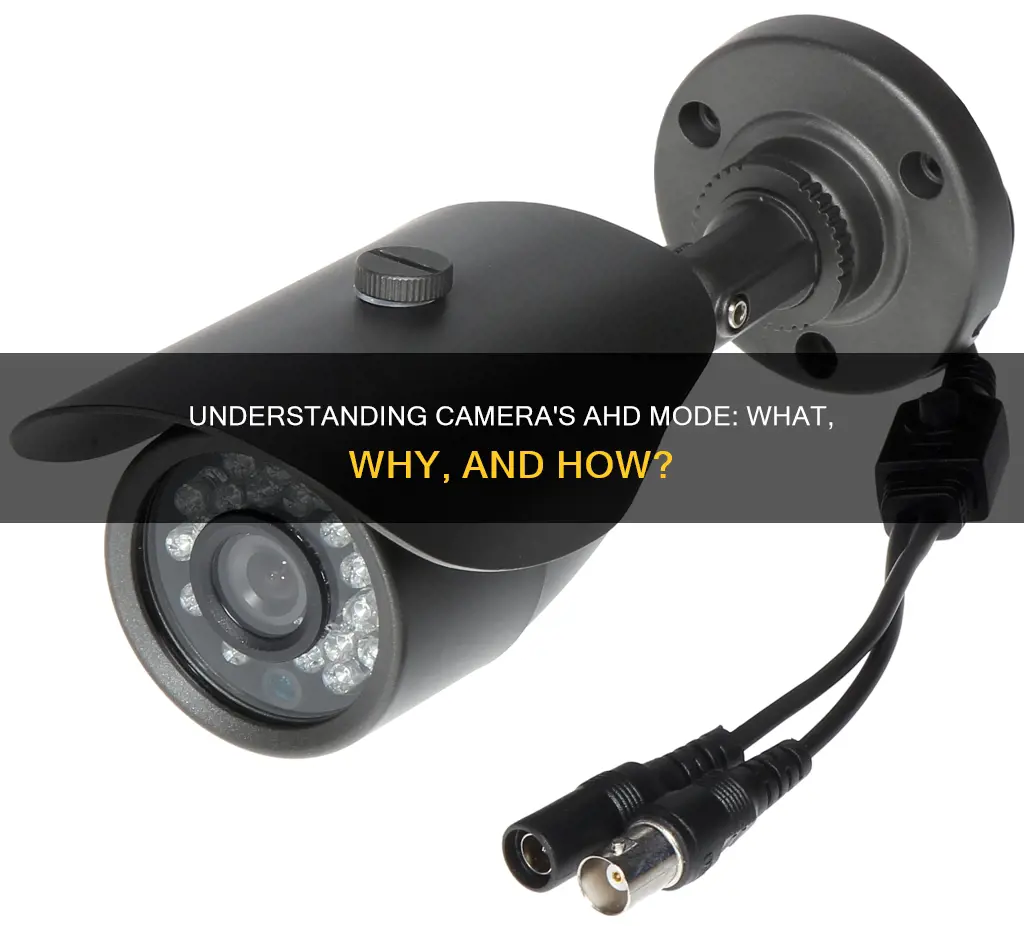
AHD stands for Analog High Definition and is a type of CCTV camera. AHD cameras have better video quality than analog cameras, providing 720p resolution output on the same transmission line. They are also capable of capturing high-definition video surveillance of up to 8MP resolution. AHD cameras can transmit video, audio, and control data over a single coaxial cable, making them cost-effective and convenient. They are a good choice for both domestic and commercial use, offering high-quality images at a reasonable price.
What You'll Learn

AHD vs 960H Video Resolution
AHD (Analog High Definition) is a video surveillance standard that uses coax cable to transmit HD video from security cameras to DVRs. AHD supports 720p, 1080p, 4K, and other HD video resolutions. 960H, on the other hand, is the latest video resolution used by analog CCTV camera surveillance systems. The resolution of 960H is 960 x 480 (NTSC) or 960 x 576 (PAL). 960H has a widescreen aspect ratio of 16:9, making it suitable for modern widescreen format monitors and HDTVs.
When comparing AHD vs 960H, the key difference is in their resolutions. AHD offers higher resolutions such as 720p, 1080p, and 4K, resulting in sharper and more detailed images. 960H, with its resolution of 960 x 480 or 960 x 576, provides a lower-resolution image.
In terms of image quality, AHD has the advantage due to its higher resolution capabilities. AHD cameras can capture more detailed and clearer images, especially in motion scenes, thanks to their progressive scan technology. Additionally, AHD cameras are more widely accepted and used in today's analog video surveillance applications.
However, 960H cameras have their benefits too. 960H cameras based on Sony Effio technology have better light sensitivity, making them suitable for low-light conditions. Additionally, 960H cameras provide a wider aspect ratio compared to standard D1 resolution cameras, resulting in a wider image without sacrificing image quality.
It's important to note that the choice between AHD and 960H depends on specific requirements and preferences. AHD cameras are ideal for those seeking higher resolutions and sharper images, especially in video surveillance applications with motion scenes. On the other hand, 960H cameras may be preferred for their compatibility with widescreen monitors and low-light performance, especially if based on Sony Effio technology.
Quickly Recover Deleted Camera Raw Files
You may want to see also

AHD vs HD-SDI Cameras
AHD (Analog High Definition) cameras are a type of HD over coax solution, which provides high-definition video surveillance at an affordable price point. They utilise analog signals to transmit high-resolution images, resulting in clear and detailed footage. AHD cameras are compatible with existing coaxial cables, making them a cost-effective upgrade option for those with existing CCTV systems. They are also known for their ease of installation, following a plug-and-play approach that does not require extensive technical knowledge.
On the other hand, HD-SDI (High-Definition Serial Digital Interface) cameras are a type of digital HD solution. They offer true high-definition video transmission and are commonly used as a replacement for old analog camera systems. HD-SDI cameras support full 1080p resolution and provide uncompressed video data, resulting in superior image quality. They are also suitable for real-time monitoring applications as they provide live video feed without noticeable delay. Additionally, HD-SDI cameras are compatible with existing coaxial cabling infrastructure, making the upgrade process seamless and cost-effective.
When comparing AHD vs HD-SDI cameras, it's important to consider factors such as cost, ease of installation, and image quality. AHD cameras are typically more affordable and easier to install, especially for those with existing CCTV systems. They provide high-definition video surveillance and are suitable for both residential and commercial applications. However, they may have limitations in terms of advanced features and resolution compared to HD-SDI cameras.
HD-SDI cameras, on the other hand, offer superior image quality with full 1080p resolution and uncompressed video transmission. They are an excellent choice for applications requiring real-time monitoring and immediate action. HD-SDI cameras are also compatible with existing coaxial cabling, making them a flexible option for upgrading from analog to digital surveillance systems. However, HD-SDI cameras may require more technical expertise during installation and may have higher bandwidth requirements.
In summary, both AHD and HD-SDI cameras have their advantages. AHD cameras are cost-effective, easy to install, and provide high-definition video surveillance. HD-SDI cameras offer superior image quality, real-time monitoring capabilities, and compatibility with existing coaxial cabling. The choice between the two depends on specific requirements, budget, and the level of detail needed in the video footage.
Apple Cameras: Night Mode Feature Explained
You may want to see also

AHD vs IP Cameras
AHD (Analogue High Definition) cameras and IP (Internet Protocol) cameras are both used for surveillance and security purposes. They differ in the technology they use and have their own advantages and disadvantages.
AHD cameras are analogue cameras that capture videos of intrusions, which are then transmitted to a Digital Video Recorder (DVR) for recording and later viewing. They are harder to install than IP cameras as they require multiple cables to be correctly connected. They are also less flexible and scalable as they are a closed-circuit system, meaning everything is hard-wired. However, they are more secure than IP cameras as intruders would have to be physically present to interfere with the camera.
IP cameras, on the other hand, capture images, convert them to digital format, and transmit them via local network connections. They offer superior image quality and a wider field of view compared to AHD cameras. They are also easier to install as they can be powered over Ethernet, requiring fewer cables. IP cameras are more flexible and scalable as they can be easily integrated into existing network infrastructure and additional cameras can be added to the network. They also offer remote access to footage, which is particularly useful for remote monitoring. However, they are generally more expensive than AHD cameras and may require more technical expertise for setup and configuration.
In summary, AHD cameras are a more secure option but IP cameras offer improved image quality, flexibility, and remote access. The choice between the two depends on specific requirements such as image quality, scalability, compatibility, budget, and desired features.
DNG and ARW: Adobe's Camera Raw Compatibility Mystery
You may want to see also

AHD vs Analogue Cameras
AHD stands for Analog High Definition and is a type of CCTV (closed-circuit television) video surveillance system. AHD cameras allow high-definition video signals to travel through traditional analogue coaxial cables. This solves the issue of transmission distance limitations and allows for an increase in definition and dynamic range.
AHD cameras are connected to DVRs (digital video recorders) using the same type of coaxial cable as traditional analogue CCTV cameras, typically RG59 or RG6 coax cable. One advantage of AHD over HD-SDI cameras is that RG59 coax cable can be run for long distances without video loss.
AHD cameras can also use UTP cable with video baluns to run cable up to 320m/960ft with CAT5 cable. AHD cameras now support 4K video resolution, as well as 720p and 1080p HD.
Analogue cameras are traditional cameras used in CCTV systems. They send video over cable to VCRs or DVRs. They have lower video quality than IP cameras and more limited site ranges. They also don't offer the same zoom-in clarity as IP cameras. Analogue cameras have more cabling requirements than IP cameras, for instance, they need a separate cable to control the pan, tilt and zoom functions.
IP cameras are all-digital cameras that can send signals over cable to be stored in the network. They provide higher video quality than analogue cameras and offer more site range options, such as wide or narrow fields of view. IP cameras also have better zoom-in capabilities, making them much better for facial recognition or detecting license plates.
IP cameras can be powered over a twisted-pair Ethernet cable, whereas older analogue cameras cannot be PoE (powered over Ethernet) powered. IP cameras can also be wireless, which can be useful in buildings where it is impractical or impossible to run cables.
IP cameras offer more advanced features than analogue cameras, such as advanced night vision and multi-exposure wide dynamic range technology. They also offer more expandability and scalability due to their less complex cabling requirements.
However, AHD cameras are cheaper than IP cameras, with a 30-50% lower cost for HD analogue systems than their IP counterparts. AHD cameras are also simpler to install, as IP cameras require more expertise to connect to recorders and video management software.
Lightroom's Limit: Understanding the Largest Camera Raw Files
You may want to see also

AHD 0.8, AHD 1.0, AHD 2.0
AHD stands for Analog High Definition and is a type of CCTV camera that can transmit video, audio and control (OSD or PTZ) over a single coaxial cable. AHD cameras are a cost-effective solution for high-definition surveillance systems, as they are around the same price as older analog CCTV technology.
AHD has three versions: AHD 0.8, AHD 1.0, and AHD 2.0. These versions correspond to different levels of resolution and compatibility with other systems.
AHD 0.8 delivers a resolution of 960H and is compatible with traditional analog cameras and DVRs. This version is often chosen for its back-compatibility with conventional analog video surveillance systems.
AHD 1.0 supports 720p high-definition video capturing and recording. It works with 960P/720P/960H AHD cameras.
AHD 2.0 supports 1080p full high-definition resolution. It is compatible with 1080P/960P/720P/960H AHD cameras.
There is also mention of an upcoming AHD 3.0 with megapixel resolution.
When selecting an AHD DVR, it is important to consider the number of channels, recording resolution, and maximum fps. AHD DVRs offer different recording formats, which can be confusing for users. It is worth noting that AHD products are designed for the low-end analog video surveillance market, so manufacturers may not focus on developing high-end products in this category.
Troubleshooting Camera Raw: Why It Reads Wrong
You may want to see also







